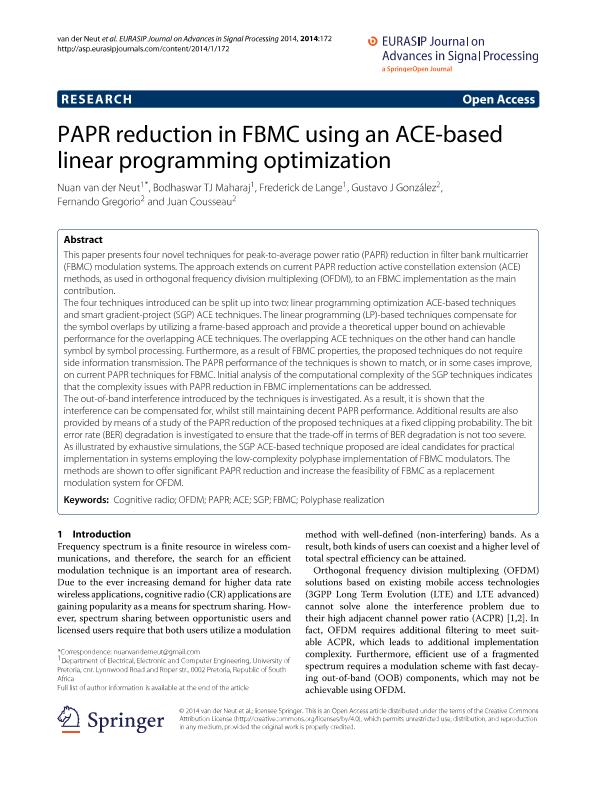Artículo
PAPR reduction in FBMC using an ACE-based linear programming optimization
Van Der Neut, Nuan ; Maharaj, Bodhaswar T. J.; de Lange, Frederick ; González, Gustavo José ; Gregorio, Fernando Hugo
; Gregorio, Fernando Hugo ; Cousseau, Juan Edmundo
; Cousseau, Juan Edmundo
 ; Gregorio, Fernando Hugo
; Gregorio, Fernando Hugo ; Cousseau, Juan Edmundo
; Cousseau, Juan Edmundo
Fecha de publicación:
12/2014
Editorial:
Springer
Revista:
Eurasip Journal on Advances in Signal Processing
ISSN:
1687-6172
e-ISSN:
1687-6180
Idioma:
Inglés
Tipo de recurso:
Artículo publicado
Clasificación temática:
Resumen
This paper presents four novel techniques for peak-to-average power ratio (PAPR) reduction in filter bank multicarrier (FBMC) modulation systems. The approach extends on current PAPR reduction active constellation extension (ACE) methods, as used in orthogonal frequency division multiplexing (OFDM), to an FBMC implementation as the main contribution. The four techniques introduced can be split up into two: linear programming optimization ACE-based techniques and smart gradient-project (SGP) ACE techniques. The linear programming (LP)-based techniques compensate for the symbol overlaps by utilizing a frame-based approach and provide a theoretical upper bound on achievable performance for the overlapping ACE techniques. The overlapping ACE techniques on the other hand can handle symbol by symbol processing. Furthermore, as a result of FBMC properties, the proposed techniques do not require side information transmission. The PAPR performance of the techniques is shown to match, or in some cases improve, on current PAPR techniques for FBMC. Initial analysis of the computational complexity of the SGP techniques indicates that the complexity issues with PAPR reduction in FBMC implementations can be addressed. The out-of-band interference introduced by the techniques is investigated. As a result, it is shown that the interference can be compensated for, whilst still maintaining decent PAPR performance. Additional results are also provided by means of a study of the PAPR reduction of the proposed techniques at a fixed clipping probability. The bit error rate (BER) degradation is investigated to ensure that the trade-off in terms of BER degradation is not too severe. As illustrated by exhaustive simulations, the SGP ACE-based technique proposed are ideal candidates for practical implementation in systems employing the low-complexity polyphase implementation of FBMC modulators. The methods are shown to offer significant PAPR reduction and increase the feasibility of FBMC as a replacement modulation system for OFDM.
Palabras clave:
Cognitive Radio
,
Ofdm
,
Papr
,
Ace
,
Sgp
,
Fbmc
,
Polyphase Realization
Archivos asociados
Licencia
Identificadores
Colecciones
Articulos(IIIE)
Articulos de INST.DE INVEST.EN ING.ELECTRICA "A.DESAGES"
Articulos de INST.DE INVEST.EN ING.ELECTRICA "A.DESAGES"
Citación
Van Der Neut, Nuan ; Maharaj, Bodhaswar T. J.; de Lange, Frederick ; González, Gustavo José; Gregorio, Fernando Hugo; et al.; PAPR reduction in FBMC using an ACE-based linear programming optimization; Springer; Eurasip Journal on Advances in Signal Processing; 172; 12-2014; 1-21
Compartir
Altmétricas



